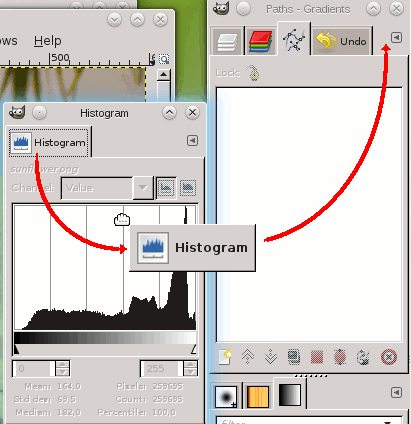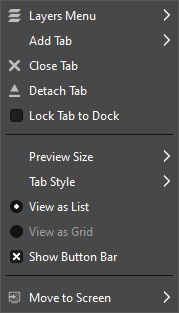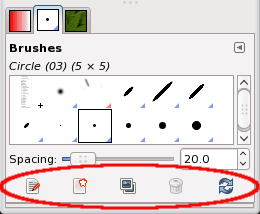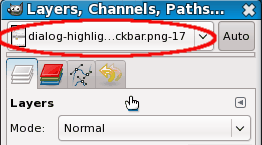GIMP has great flexibility for arranging dialogs on your screen. A “dialog” is a moving window which contains options for a tool or is dedicated to a special task. A “dock” is a container which can hold a collection of persistent dialogs, such as the Tool Options dialog, Brushes dialog, Palette dialog, etc. Docks cannot, however, hold non-persistent dialogs such as the Preferences dialog or the image window.
GIMP有三个默认的停靠栏:
-
the Tool Options, Device Status, Undo History and Images dock under the Toolbox in the left panel,
-
the Brushes, Patterns, Fonts and Document History dock in the upper part of the right panel,
-
the Layers, Channels and Paths dock in the lower part of the right panel.
在这些停靠栏中,每个对话框位于它们自己的选项卡中。
在多窗口模式下,工具箱是一个实用程序窗口而不是停靠栏。在单窗口模式下,它属于单窗口。
使用 → 查看可停靠对话框列表。从列表中选择一个可停靠的对话框以查看该对话框。如果对话框在停靠栏中可用,则它是可见的。如果对话框不在停靠栏中,则多窗口模式和单窗口模式下的行为会有所不同:
-
在多窗口模式下,屏幕上会出现一个包含对话框的新窗口。
-
In single-window mode, the dialog is automatically docked to the Brushes-Document History dock as a tab.
您可以点击并拖动选项卡并将其放在想要的位置:
-
在停靠栏的选项卡栏中,将其集成到对话框组中,
-
或者在显示为蓝线的停靠栏上,当鼠标指针移过停靠栏边框时,将对话框锚定到停靠栏。
在多窗口模式下,您还可以点击对话框标题并将其拖动到所需位置。
更简单的:选项卡菜单第 2.3.2 节 “选项卡菜单”中的添加选项卡命令。
图 3.8. 将对话框锚定到停靠边框
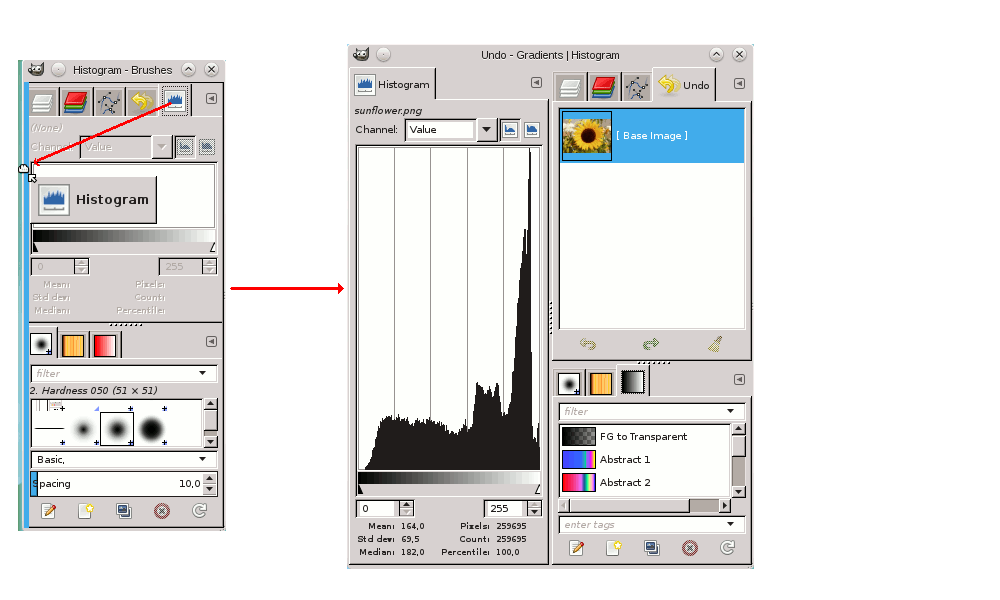
直方图对话框拖动到右侧面板的左侧竖直停靠栏,结果:对话框锚定到右侧面板的左边框。此对话框现在属于右侧面板。
因此,您可以在多列显示中排布对话框,如果您使用两个屏幕,一个用于对话框,另一个用于图像,会很有趣。
![[提示]](images/tip.png)
|
提示 |
|---|---|
|
Press the Tab key in the image window to toggle the visibility of the docks. This is useful if the docks hide a portion of the image window. You can quickly hide all the docks, do your work, then display all the docks again. Press the Tab key inside a dock to navigate through the dock. |
In each dialog, you can access a special menu of tab-related operations by
pressing the Tab Menu button
.
The exact commands shown in the menu depend on the active dialog, but
they always include operations for creating new tabs, closing or
detaching tabs.
选项卡菜单可让您访问以下命令:
- 上下文菜单
-
在每个选项卡菜单的顶部,有一个条目打开对话框的上下文菜单,其中包含特定于该对话框特定类型的操作。例如,图层选项卡的上下文菜单是图层菜单,其中包含一组用于操作图层的操作。
- 添加选项卡
-
添加选项卡打开一个子菜单,允许您将各种可停靠的对话框添加为新选项卡。
- 关闭选项卡
-
Close the dockable dialog. Closing the last dialog in a dock causes the dock itself to close.
- 分离选项卡
-
从停靠栏分离对话框,创建一个新停靠栏,并将分离的对话框作为其唯一成员。它与将选项卡拖出停靠栏并在无法停靠的位置释放它具有相同的效果。
在单窗口模式下,这是一种创建一个矛盾的新窗口的方法!
If the tab is locked, this menu item is disabled.
- 锁定选项卡到停靠栏
-
Prevent the dialog from being moved or detached. When activated, is disabled.
- 预览大小
-
Many, but not all, dialogs have Tab menus containing a Preview Size option, which opens a submenu giving a list of sizes for the items in the dialog, from small to large. For example, the Brushes dialog shows pictures of all available brushes: the Preview Size determines how large the pictures are. The default is Medium size.
- 选项卡样式
-
Tab Style opens a submenu allowing you to choose the appearance of the tabs at the top. There are five choices, but not all are enabled for every dialog:
- Icon
-
使用图标来表示对话框类型。
- 当前状态
-
仅适用于允许您选择某些东西,例如画笔、图案、渐变等的对话框。当前状态在选项卡顶部显示当前所选项目的图标。
- 文本
-
使用文本显示对话框类型。
- 图标和文本
-
同时使用图标和文本会产生更宽的选项卡。
- 状态和文本
-
显示当前选定的项目和对话框类型的文本。
- View as List, 以网格方式查看
-
这些条目显示在对话框中,允许您从一组项目(笔刷、图案、字体等)中选择一个项目。您可以选择将项目作为竖直列表查看,每个项目旁边都有名称;或者作为网格查看,带有项目的图标,但没有名称。每种方法都有其优点:以列表方式查看可为您提供更多信息,但以网格方式查看可让您同时看到更多。默认设置因对话框而异:对于笔刷和图案,默认为网格;对于大多数其他对话框,默认是一个列表。
当树视图为以列表方式查看时,您可以使用标签。请参见第 3.7 节 “Tagging”。
您也可以使用列表搜索字段:
图 3.11. 列表搜索字段。
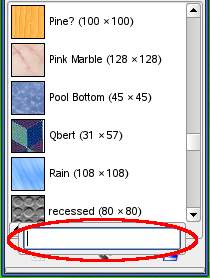
Press Ctrl+F to open the list search field, displayed at the bottom. An item must be selected for this command to be effective.
如果您什么都不做,列表搜索字段会在五秒后自动关闭。
![[注意]](images/note.png)
注意 搜索字段快捷方式也可用于您在多个工具的“笔刷”、“字体” 或“图案” 选项中获得的树视图。
- 显示按钮栏
-
一些对话框在对话框底部显示一个按钮栏;例如,图案、画笔、渐变和图像对话框。这是一个开关。如果选中,则显示按钮栏。
- 显示图像选择
-
This option is available in multi-window mode only. This is a toggle. If it is checked, then the active image is shown at the top of the dock:
It is not available for dialogs docked below the Toolbox. This option is interesting only if you have several open images on your screen. - 自动跟随活动图像
-
此选项仅在多窗口模式下可用。只有当您在屏幕上打开多个图像时,此选项很有趣。然后,停靠栏中显示的信息始终是图像选择下拉列表中所选图像的信息。如果禁用自动跟随活动图像,则只能在图像选择中选择图像。如果启用,您也可以通过直接激活图像(单击其标题栏)来选择它。
- Move to Screen
-
The option is an experimental functionality to choose a different display.
